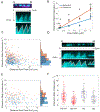Clusters of a Few Bound Cofilins Sever Actin Filaments
- PMID: 33524412
- PMCID: PMC8689643
- DOI: 10.1016/j.jmb.2021.166833
Clusters of a Few Bound Cofilins Sever Actin Filaments
Abstract
Cofilin is an essential actin filament severing protein that accelerates the assembly dynamics and turnover of actin networks by increasing the number of filament ends where subunits add and dissociate. It binds filament subunits stoichiometrically and cooperatively, forming clusters of contiguously-bound cofilin at sub-saturating occupancies. Filaments partially occupied with cofilin sever at boundaries between bare and cofilin-decorated segments. Imaging studies concluded that bound clusters must reach a critical size (Cc) of 13-100 cofilins to sever filaments. In contrast, structural and modeling studies suggest that a few or even a single cofilin can sever filaments, possibly with different severing rate constants. How clusters grow through the cooperative incorporation of additional cofilin molecules, specifically if they elongate asymmetrically or uniformly from both ends and if they are modulated by filament shape and external force, also lacks consensus. Here, using hydrodynamic flow to visualize individual actin filaments with TIRF microscopy, we found that neither flow-induced filament bending, tension, nor surface attachment conditions substantially affected the kinetics of cofilin binding to actin filaments. Clusters of bound cofilin preferentially extended toward filament pointed ends and displayed severing competency at small sizes (Cc < 3), with no detectable severing dependence on cluster size. These data support models in which small clusters of cofilin introduce local, but asymmetric, structural changes in actin filaments that promote filament severing with a rate constant that depends weakly on the size of the cluster.
Keywords: curvature; fluorescence; kinetics; microfluidics; tension.
Copyright © 2021. Published by Elsevier Ltd.
Conflict of interest statement
Declaration of Competing Interest The authors declare no competing interest.
Figures




Similar articles
-
Structures of cofilin-induced structural changes reveal local and asymmetric perturbations of actin filaments.Proc Natl Acad Sci U S A. 2020 Jan 21;117(3):1478-1484. doi: 10.1073/pnas.1915987117. Epub 2020 Jan 3. Proc Natl Acad Sci U S A. 2020. PMID: 31900364 Free PMC article.
-
Molecular origins of cofilin-linked changes in actin filament mechanics.J Mol Biol. 2013 Apr 12;425(7):1225-40. doi: 10.1016/j.jmb.2013.01.020. Epub 2013 Jan 24. J Mol Biol. 2013. PMID: 23352932 Free PMC article.
-
The actin filament twist changes abruptly at boundaries between bare and cofilin-decorated segments.J Biol Chem. 2018 Apr 13;293(15):5377-5383. doi: 10.1074/jbc.AC118.001843. Epub 2018 Feb 20. J Biol Chem. 2018. PMID: 29463680 Free PMC article.
-
Biophysics of actin filament severing by cofilin.FEBS Lett. 2013 Apr 17;587(8):1215-9. doi: 10.1016/j.febslet.2013.01.062. Epub 2013 Feb 5. FEBS Lett. 2013. PMID: 23395798 Free PMC article. Review.
-
Tropomyosin and ADF/cofilin as collaborators and competitors.Adv Exp Med Biol. 2008;644:232-49. doi: 10.1007/978-0-387-85766-4_18. Adv Exp Med Biol. 2008. PMID: 19209826 Review.
Cited by
-
Single-molecule analysis of actin filament debranching by cofilin and GMF.Proc Natl Acad Sci U S A. 2022 Jul 19;119(29):e2115129119. doi: 10.1073/pnas.2115129119. Epub 2022 Jul 11. Proc Natl Acad Sci U S A. 2022. PMID: 35858314 Free PMC article.
-
Deciphering the actin structure-dependent preferential cooperative binding of cofilin.Elife. 2024 Aug 2;13:RP95257. doi: 10.7554/eLife.95257. Elife. 2024. PMID: 39093938 Free PMC article.
-
Trends in Single-Molecule Total Internal Reflection Fluorescence Imaging and Their Biological Applications with Lab-on-a-Chip Technology.Sensors (Basel). 2023 Sep 6;23(18):7691. doi: 10.3390/s23187691. Sensors (Basel). 2023. PMID: 37765748 Free PMC article. Review.
-
Cofilin-mediated actin filament network flexibility facilitates 2D to 3D actomyosin shape change.Eur J Cell Biol. 2024 Mar;103(1):151379. doi: 10.1016/j.ejcb.2023.151379. Epub 2023 Dec 26. Eur J Cell Biol. 2024. PMID: 38168598 Free PMC article.
-
Twinfilin1 controls lamellipodial protrusive activity and actin turnover during vertebrate gastrulation.J Cell Sci. 2021 Jul 15;134(14):jcs254011. doi: 10.1242/jcs.254011. Epub 2021 Jul 19. J Cell Sci. 2021. PMID: 34060614 Free PMC article.
References
Publication types
MeSH terms
Substances
Grants and funding
LinkOut - more resources
Full Text Sources
Other Literature Sources

